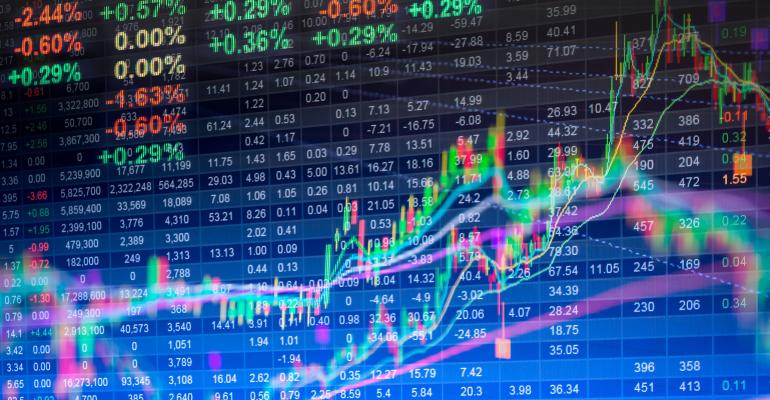By Dani Burger
(Bloomberg) --Call it the curious case of the tail wagging the VIX.
The U.S. stock market’s main volatility gauge -- the CBOE Volatility Index, better known as the VIX -- is at its lowest level since 2007. That seems strange in light of the geopolitical anxiety surrounding the French elections, the saber rattling with North Korea and the mixed fiscal and economic signals coming from the U.S.
While gallons of ink have been spilled on whether the VIX is “ broken,” some traders are now suggesting that exchange-traded products linked to the index have a hand in the perceived distortion. What’s more, they warn, their popularity -- VIX ETPs have absorbed $700 million this year -- could exacerbate a selloff if volatility spikes.
“Does the mere existence of these products change the market - especially now that so many are talking about these products and apparently trading them?” Peter Tchir, head of macro strategy at Brean Capital LLC., wrote in a note to clients last month. “I think the depth of liquidity is too low and that these products do matter and can drive markets.”
The answer isn’t straightforward, thanks to the complexity of not only VIX products but of the index itself, which measures expected volatility through S&P 500 options. The VIX is a function of realized volatility, not necessarily a sentiment gauge, so it reflects what traders are willing to pay for the options.
Yet budding evidence suggests that VIX ETPs -- a more than $3 billion industry that includes the popular $1 billion iPath S&P 500 VIX Short-Term Futures ETN, symbol VXX -- have altered the futures market, and at times indirectly influenced the index itself.

Traders “buy” the VIX using futures. The backers of VIX exchange-traded notes also buy futures to keep the notes in line with their expressed exposure. This has triggered skyrocketing activity over the past decade. From 2005 to 2009, the year before VXX was created, average daily volume was 1,050 first-month contracts. The average this year is nearly 96,000.
“The ETPs don’t generate demand on their own, ETPs just make it more convenient,” said Dave Nadig, chief executive officer of San Francisco-based research firm ETF.com “Things get distorted when you restrict access.”
Most strategists believe there are stronger forces than ETPs keeping the VIX low. An accommodative Federal Reserve and European Central Bank, strong earnings, low sector correlation and numerous other positive market indicators have capped pessimism, they say.
“There is an overwhelming market narrative that equates to ‘Don’t worry, be happy’,” Nick Colas, the firm’s chief market strategist, wrote in a note to clients Tuesday.
Though ETPs increased the liquidity of VIX futures, the real issue is whether they influence prices. That’s less obvious and centers around a phenomenon know as a roll forward.
Long-VIX ETPs “roll” contracts to maintain their exposure. Each day they’ll sell the front-month contract and buy more of the second-month contract. This can suppress the price of the front-month and raise the cost of the second -- steepening the front end of the curve into an upward slope known as a contango. While no one is saying that ETPs alone can alter the curve, steepness has increased with the uptick in the products’ assets.

Another issue is what impact this has on the VIX itself. Though the relationship between futures prices and ETPs is clearer and easier to arbitrage, the link between S&P 500 Index options and ETPs is hazier, said John Hiatt, director of research at CBOE.
“The ETPs will indirectly have an impact. People who are trading the products are trading S&P 500 options as well, which will be colored by what they’re doing in the ETPs,” Hiatt said. “Then you have what actually occurs in the S&P 500, and that’s the primary driver and everything responds to that.”
It’s difficult to prove that ETPs apply constant pressure that pushes the VIX lower, according to Ramon Verastegui, head of flow strategy and solutions in the Americas at Societe Generale SA. Still, with ETPs looming as such a large market presence, they affect the VIX’s term structure while the threat of a sell-off hangs over the index. When VIX futures move 1 point, typically the VIX spot price moves 1 to 2 points, Verastegui said.

But some analysts believe that ETP influence has been waning of late. They accounted for one-third of VIX futures open interest last year, and dropped to 22 percent in the first quarter of 2017, data from Goldman Sachs Group Inc. show. Demand for the futures jumped this year, while assets in VIX ETPs remained somewhat constant.
Besides the exchange-traded products, demand for VIX futures is partially attributed to the cheap spot price, and the propensity of the VIX Index to mean revert. At the same time, shorting VIX futures has the appeal of easy money for institutional funds. Contango means that hedge funds can take advantage of the discrepancy by selling second-month VIX futures and buying front-month.
So, yes, VIX ETPs can’t take all, or even most, of the the blame for driving down implied volatility. But their sudden and rapidly growing popularity leaves more than a nagging suspicion that they’re influencing volatility measurements.
“When you increase access to something that’s naturally going to be upward sloping, you’d expect ETPs to be accelerating that,” Nadig said. “I don’t think that’s a bad thing. It’s a pretty accurate reflection of sentiment.”
To contact the reporter on this story: Dani Burger in New York at [email protected] To contact the editors responsible for this story: Jeremy Herron at [email protected] Eric J. Weiner





